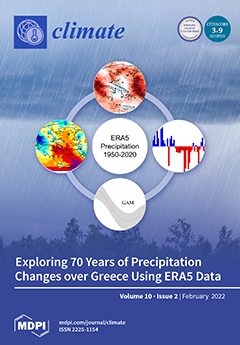The Athabasca Oil Sands Area (AOSA) in Alberta, Canada, is considered to have a high density of weather stations. Therefore, our objective was to determine an optimal network for the wind data measurement that could sufficiently represent the wind variability in the area.
[...] Read more.
The Athabasca Oil Sands Area (AOSA) in Alberta, Canada, is considered to have a high density of weather stations. Therefore, our objective was to determine an optimal network for the wind data measurement that could sufficiently represent the wind variability in the area. We used available historical data records of the weather stations in the three networks in AOSA, i.e., oil sands monitoring (OSM) water quantity program (WQP) and Wood Buffalo Environmental Association (WBEA) edge sites (ES) and meteorological towers (MT) of the air program. Both graphical and quantitative methods were implemented to find the correlations and similarities in the measurements between weather stations in each network. The graphical method (wind rose diagram) was found as a functional tool to understand the patterns of wind directions, but it was not appropriate to quantify and compare between wind speed data of weather stations. Therefore, we applied the quantitative method of the Pearson correlation coefficient (
r) and absolute average error (AAE) in finding a relationship between the wind data of station pairs and the percentage of similarity (PS) method in quantifying the closeness/similarity. In the correlation analyses, we found weak to strong correlations in the wind data of OSM WQP (
r = 0.04–0.69) and WBEA ES (
r = 0.32–0.77), and a strong correlation (
r = 0.33–0.86) in most of the station pairs of the WBEA MT network. In the case of AAE, we did not find any acceptable value within the standard operating procedure (SOP) threshold when logically combining the values of the
u and
v components together. In the similarity analysis, minor similarities were identified between the stations in the three networks. Hence, we presumed that all weather stations would be required to measure wind data in the AOSA.
Full article





